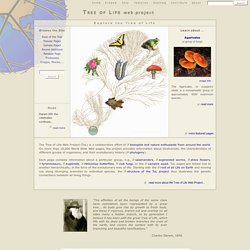

Handbook Illustrations. Where the World Finds Bioethics. Discover Life. A Little Trick for Converting Centigrade to Fahrenheit. BioRxiv.org - the preprint server for Biology. pAbmAbs antibody blog and review site. The Antibody Registry. ELISA Kits - Antibodies - Research Products. Antibodypedia. Learn Science at Nature. H-O-H+ Water Revue. Aquaporins. Water in situ. Water Solutions. Water Research. Internet Medicine the Homesite of Digitalization of Healthcare. Chemical Analysis, Life Sciences, and Diagnostics. Nature Institute: Viewing Nature, Science, and Technology in Context. SCIENCE.
Botany. Genomics. New Organica. New Health Concerns. New Research Info. New Sciences. Emerging Trends. Resource Collections - BioEd Online. Tree of Life Web Project. The Tree of Life Web Project (ToL) is a collaborative effort of biologists and nature enthusiasts from around the world.

On more than 10,000 World Wide Web pages, the project provides information about biodiversity, the characteristics of different groups of organisms, and their evolutionary history (phylogeny). Each page contains information about a particular group, e.g., salamanders, segmented worms, phlox flowers, tyrannosaurs, euglenids, Heliconius butterflies, club fungi, or the vampire squid.
ToL pages are linked one to another hierarchically, in the form of the evolutionary tree of life. Starting with the root of all Life on Earth and moving out along diverging branches to individual species, the structure of the ToL project thus illustrates the genetic connections between all living things. Images - Les Sciences de la Vie au Lycée.
Cell Size and Scale. Some cells are visible to the unaided eye The smallest objects that the unaided human eye can see are about 0.1 mm long.

That means that under the right conditions, you might be able to see an ameoba proteus, a human egg, and a paramecium without using magnification. A magnifying glass can help you to see them more clearly, but they will still look tiny. Smaller cells are easily visible under a light microscope. It's even possible to make out structures within the cell, such as the nucleus, mitochondria and chloroplasts.
To see anything smaller than 500 nm, you will need an electron microscope. Adenine The label on the nucleotide is not quite accurate. How can an X chromosome be nearly as big as the head of the sperm cell? No, this isn't a mistake. Cell. Cells... World of biodiversity. Center for Biological Diversity. Biodiversity explorer. Oscillatorium Site Index in Map Format. Microbial Life - Educational Resources. Teaching and learning about the diversity, ecology and evolution of the microbial world; discover the connections between microbial life, the history of the earth and our dependence on micro-organisms.

The expansive Sunset Lake of the Black Sand Basin is one of the largest thermal bodies of water in Yellowstone National Park. Details This site contains a variety of educational and supporting materials for students and teachers of microbiology. You will find information about microorganisms, extremophiles and extreme habitats, as well as links to online provides information about the ecology, diversity and evolution of micro-organisms for students, K-12 teachers, university faculty, and the general public.
Microbial Life in Extreme Environments: Mammoth Terraces, Yellowstone National Park. Microbial Life in Marine Environments: Pancake ice in Ross Sea, Antarctica. Find out more about the myriad of microorganisms that live in marine environments. Microbial Observatories: Research Methods: Marine Stewardship Council - home — MSC. Search SeaLifeBase. Taxa selector (root) Wikispecies - the species directory. Welcome to Reactome Pathway Database. Médecine et autre.